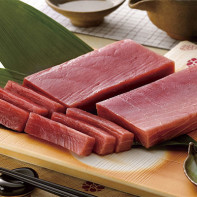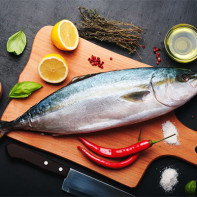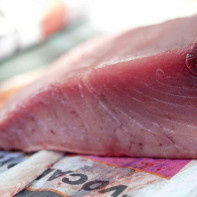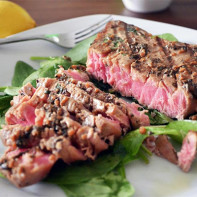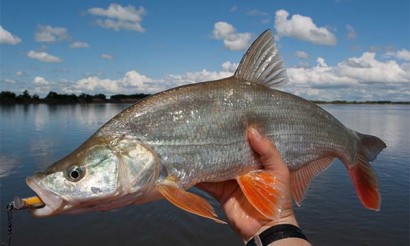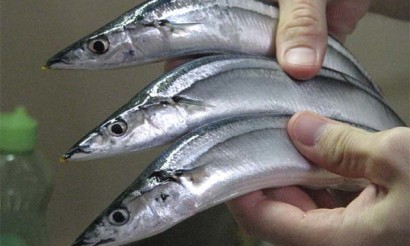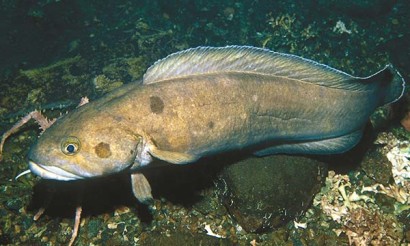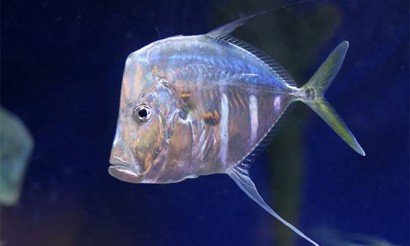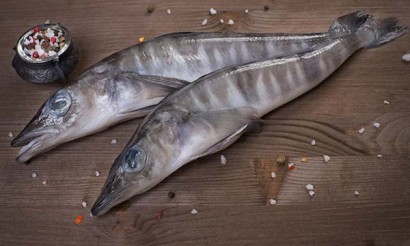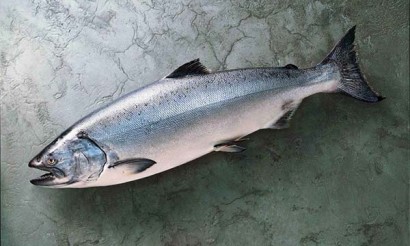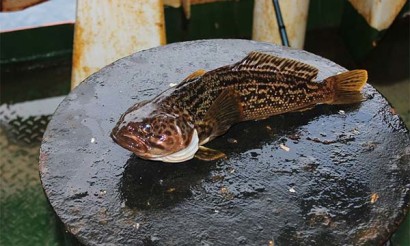Tuna fish: photo, description, useful properties and recipes
Tuna is considered one of the most popular sea creatures. Dishes of this delicious fish occupy a central place not only in Japanese national cuisine. Culinarians almost all over the world love to prepare delicacies from the tender tuna meat. Unfortunately, the popularity has not been good for this representative of the mackerel fish, with environmentalists sounding the alarm about a marked decline in the tuna population. After all, in America alone, tuna species account for almost 50% of the total fish processing industry. For this reason, measures are now being taken around the world to rebuild the numbers of this valuable commercial fish. This factor explains the high cost of tuna, although it is still freely available in fresh and canned form.
- Tuna: what kind of fish, how it looks and where it is found
- Features of the fish
- Appearance signs
- Nutrition
- Habitat
- Lifestyle
- Types
- Composition and calories
- How tuna is useful
- General benefits
- For Women
- For Men
- If Pregnant
- For breastfeeding
- For children
- For weight loss
- The benefits and harms of canned tuna
- Can I Eat Tuna with Various Diseases
- Diabetes.
- For pancreatitis
- For gastritis
- With gout
- Harm and Contraindications
- How to choose and store
- How to cut the tuna properly
- How to cook tuna perfectly: Recipes
- In the oven
- In the frying pan
- On the grill
- In a multicooker
- On the grill
- What to cook with tuna: Recipes
- Salad
- Tartar
- Soup
- Pate
- Carpaccio
- Cutlets
- Can I Eat Raw Tuna
- Interesting Facts
Tuna meat is very good for human health. Therefore, it is an integral part of many dietary programs. But in order to use the valuable product correctly, it is not superfluous to get acquainted with tuna and learn the features of this extraordinary representative of marine fauna.
Tuna: what kind of fish it is, how it looks and where it lives
It is known for certain that Japanese fishermen were actively fishing for tuna even 5 thousand years ago. This fact is confirmed by numerous historical documents. For its impressive body size and atypical for fish taste tuna is often called "sea calf".
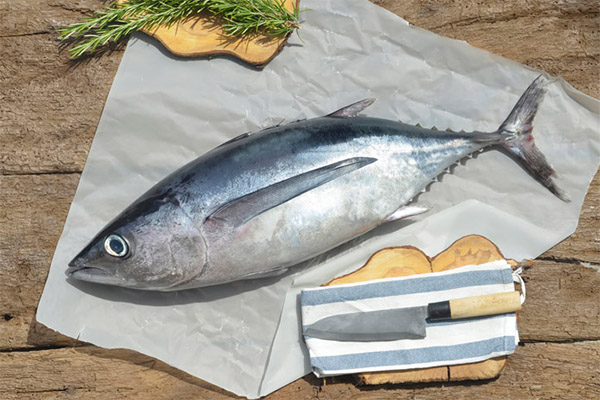
The features of the fish
Tuna belongs to the family of mackerel fish, which demonstrate high speed when moving. There were cases when this giant fish for an hour overcome the distance of over 90 km. Due to the high physical activity in the muscle tissues is formed in huge quantities of substance myoglobin, which gives the meat product uncharacteristic for fish meat color. But, in addition to speed records, tuna has become famous for its enormous size: known case when fishermen caught an individual over 4.5 m long and weighing about 700 kg, which is comparable to the weight of a car.
The tuna has a very developed circulatory system, which distinguishes it from other popular marine fish species. In principle, the entire network of blood vessels is an autonomous temperature regulator. Another peculiarity is that the tuna is forced to be in constant motion, because a decrease in speed, as well as a complete stop, threatens serious disorders of respiratory functions.
External signs
The body of the tuna has an elongated, spindle-like shape. The large head and large mouth contrast with the small eyes. The color of the body on the back blue, and the lateral surfaces have a greenish hue with patches of light-colored spots. Special attention should be given to the scales, which are so strong in the front part of the body that they resemble an armored carapace. But such a cover reliably protects the sea creature from all kinds of trouble.
Nutrition
Tunas by nature are gourmands. Their daily diet consists of small fish and cephalopods. Even if they are very hungry, tuna will not eat carrion. That is why the Japanese say there are never any parasites in the meat of this fish. Residents of the Land of the Rising Sun use the delicacy in its raw form.
Habitat
Tuna likes to travel, and its migration path is not limited to a certain area. This commercial fish is found in all oceanic waters except the Arctic Ocean basin. This sea creature easily covers thousands of sea miles. Today, more than seven dozen countries, including the United States, Spain, Russia, and Japan, are involved in harvesting the valuable fish.
Lifestyle
Tunas are not prone to solitude, they prefer a gregarious lifestyle. Representatives of this species feel fine in the warm waters of the Atlantic, even away from their native shores, but can go into the depths of the sea. Tuna reproduce by laying eggs. And in this area they also set records, because in one litter of females laying up to 10 million eggs.
Species
The tuna fish genus has several dozen subspecies, among which there are large-sized and small specimens. Each individual species differs not only in appearance and size, but also in its gastronomic characteristics, in particular composition and caloric value. But among the fish diversity, seven main species can be identified as the target of commercial harvesting. On this list:
- Bluefin (common) tuna. Representatives of this species have a bluish-black body color with silvery longitudinal strips. This particular species is notable for its gigantic size. The common tuna migrates long distances and likes to settle in temperate and tropical waters, but is sometimes found in cooler areas. The meat of this fish species is used in cooking to make steaks, rolls, and sashimi.
- Whitefin tuna is often called longfin tuna. Adults reach a length of up to 1.3 m, and the largest specimens weigh up to 45 kg. Its abdomen is white with a silvery tint, and its back is colored dark blue. The habitat of representatives of this species is the Mediterranean Sea, the Atlantic, and the Pacific Ocean. Basically, the fish goes to cook canned fish.
- Yellowfin tuna has a bright coloring of the body: on a yellowish background on both sides there are noticeable blue stripes. It lives mainly in the Atlantic Ocean. Since the population of this species has drastically declined, commercial fishing is limited today. It is the yellowfin tuna that is most commonly used in culinary and food industries.
- Small Atlantic tuna prefers warm waters. Despite its much-talked-about name, this species reaches a length of over 1 meter. The lean, bright red meat of the little tuna is more suitable for canning.
- Bigeye tuna is similar to its yellowfin counterpart in many ways, but it has a much larger eye. It lives mainly in subtropical and tropical waters. It reaches 2 m or more in length and can weigh over 200 kg. It is mainly used for frying, roasting, and charcoal cooking.
- Bonito tuna does not have impressive parameters: its height is not more than 90 cm, and weight - about 23 kg. Habitat area - the tropics and subtropics. Bonito is widely used in Japanese cuisine for a number of national dishes, but dried bonito meat shavings are especially famous.
- Mackerel tuna is also considered one of the most common species. Its main distinguishing feature is the presence of a large fin with spines on the back. The back is colored in a silvery-blue shade, and wavy dark lines are clearly defined on the main background. The abdomen is white. Ideal for canning and cooking various dishes.
Composition and calories
The meat of tuna fish is saturated with a lot of useful components, which justifies the huge demand for this sea creature. Of particular value are omega fatty polyunsaturated acids, which have a beneficial effect on the condition of the skin and hair. These complex compounds stimulate brain activity, improve heart activity and strengthen the structure of the blood vessels. The tuna meat is also rich in the following no less useful substances:
- Retinol or vitamin A. This element is a powerful natural antioxidant. Its main function is to provide good protection for the immune system. Also vitamin A is very useful for the health of the eyes, stimulates regenerative processes.
- B vitamins support metabolism, improve the nervous system and metabolism. On the level of substances of this group directly affects the psycho-emotional state of the person and his ability to cope with stress. Deficiency of these vitamins is fraught with serious mental disorders and the development of multiple sclerosis.
- Tocopherol, better known as vitamin E, inhibits the aging process of the skin by exhibiting antioxidant activity. This element also affects the reproductive ability of both sexes, blood clotting and the patency of blood vessels, expanding their lumen.
- Calciferol - also known as vitamin D. In fact, it is a complex of substances necessary for the proper functioning of many organs and systems. Lack of this element negatively affects the bone and muscle system, intestines and kidneys. Not so long ago, scientists proved that the cause of some cancers may be a deficiency of calciferol in the body. So tuna fish meat can be a natural source of this essential element.
- Amino acids are present in large quantities in the muscle mass of tuna. The usefulness of these chemical compounds is difficult to overestimate, as they provide cleansing of the body from free radicals, strengthen the structure of bone tissues, muscles and tendons, and have a pronounced antibacterial effect.
- Minerals. Tuna exceeds many marine species in the content of macro-and micronutrients. In its meat, there is phosphorus, zinc, calcium and sulfur. There is cobalt, an element without which the regular process of cell renewal is impossible. Cobalt stimulates the synthesis process and slows the manifestation of age-related changes. Its deficiency has a negative effect on the endocrine system. Chromium is no less important for normal health. This element destroys "harmful" cholesterol but protects the integrity of DNA.
- Fatty acids are another group of substances that are very important for human life. They resist the development of cancer and Alzheimer's disease, which in old age leads to disastrous consequences. Fatty acids stimulate the synthesis of serotonin, a substance that is not accidentally called the "happiness hormone".
In addition to these components, tuna meat contains a lot of protein (up to 30%), which is of great value for dietary nutrition of sick people and athletes. The tuna has practically no fat and no carbohydrates. That is why the product has a low energy content of about 140 kcal per 100-gram serving. This means that tuna dishes are ideal for dietary nutrition of people who want to normalize their weight.
Important! The caloric value of canned tuna due to the oil content in the marinade is about 200 units. But if the fish is canned in its own juice, the energy value is much lower than that of fresh fish - about 110 kcal. These two important points must be taken into account when formulating your diet.
What tuna is good for
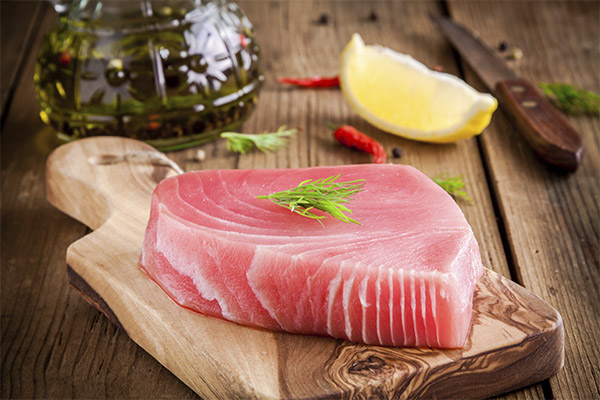
Overall Benefits
The unique, well-balanced composition of tuna meat makes it an extremely useful food for people of all ages and genders. The presence of dishes from this noble fish in the daily menu has a generally beneficial effect on the function of all organs and systems. To make sure of this, it is enough to list the main effects that ensure the presence of this representative of the mackerel fish family in the diet:
- reduces the risk of developing atherosclerosis;
- strengthens the immune system;
- has a positive effect on the musculoskeletal system;
- improves the capacity of the main blood vessels;
- lowers the concentration of bad cholesterol;
- About 2-fold reduces the risk of hypertension and heart disease;
- Normalizes the course of metabolic processes;
- has a positive effect on the sexual system;
- Inhibits the aging process;
- stimulates the regeneration of damaged tissues;
- helps to cope with the effects of depression;
- Has a pronounced anticarcinogenic effect;
- Cleanses the body of toxins and toxic compounds.
In addition, we can add that the regular consumption of tuna is an excellent means of preventing arthritis, arthritis, various visual impairments and a number of other common diseases.
Good to know! The presence of tuna dishes in the diet will be a powerful stimulant for the immune system to produce antibodies that prevent the development of allergic manifestations.
For women
Absolutely all representatives of the beautiful half of humanity, regardless of age and social status, strive to look attractive. A diet that includes tuna can be of great help in preserving their youth and beauty. The excellent antioxidant properties of this sea creature meat will protect skin cells and other tissues from the ravages of age. The high nutritional value of the product combined with its low calorie content will help maintain a slender figure.
One should not forget about such delicate aspects of life as sexual activity and the ability of women to conceive. The content of vitamins E and A in tuna meat supports fertility and reproductive capabilities of women. It is especially useful to eat this fish for menopausal women.
For Men
The representatives of the stronger sex should also pay close attention to tuna. Dishes made of this valuable fish should be a must in the diet of men who lead an active lifestyle. Tuna should be the main product in the menu of athletes because its high protein content ensures the growth of muscle mass. Moreover, the protein in the composition is easily absorbed by the body. However, in this case, it is recommended to eat fish dishes not after training, but an hour and a half before them. Such a dietary regimen will help to cope with heavy physical loads at work and maintain normal potency even at a mature age.
Taking into account the fact that tuna is able to prevent the development of cancer, men should regularly consume the meat of this fish, especially in older age. Nutritionists are advised to steam or boil the tuna. But do not be too carried away by the dishes of this expensive fish. It is enough to include such delicacies in the menu twice a week to always have a source of vitamins and nutrients.
When pregnant
The useful properties of tuna do not raise doubts. But future mothers should not introduce the nutritious meat of this sea fish in their diet, although dietitians do not give categorical prohibitions on this matter. Restrictions for pregnant women, as well as for breastfeeding women, are related to the fact that tuna meat accumulates heavy metals, which is not safe. It is also undesirable to consume protein-rich foods while carrying a child, as it can cause kidney dysfunction.
When breastfeeding
Although tuna meat belongs to the dietary foods, breastfeeding mothers should not get carried away with dishes from this delicious fish, and it is better to refuse to eat it at all for a while. The fact is that the presence of a large amount of protein can cause allergic reactions and digestive disorders in the child. There is also a risk of getting a "portion" of toxic products in the form of heavy metals together with a tasty meal. Note: the concentration of unsafe elements for health is especially high in older individuals.
For kids
Nutritionists advise against including tuna meat in the diet of children during the first three years of life, due to the potential threat posed by the mercury in the product. In the fourth year of life, a child can be given boiled tuna or steamed dishes. But it is necessary to strictly adhere to the allowable consumption standards.
With the right approach, tuna meat will only contribute to the harmonious development of the baby, and the high protein content of the product will fully cover the needs of the child's body in essential amino acids. The ideal ratio of phosphorus, vitamin D, iodine and calcium will contribute to normal growth of the child and its intellectual development.
For weight loss.
Since tuna is considered a high-protein product, dishes made of this fish should be included in the dietary complex of people with weight problems. It is better to give preference to fresh meat or canned fish in its own juice, because it is in this form tuna has low caloric values. The complete absence of carbohydrates and the low percentage of fat are also attractive for thinners. Practice shows that a diet in which tuna is the basic product, helps to lose up to 5 kg of extra weight in a week only by increasing metabolism. But such a diet will preserve muscle mass, as well as provide the body with the necessary set of vitamins and other useful elements.
As can be seen from the above advantages, tuna is that unique product that provides maximum benefit to the body of people of all ages. Therefore, nutritionists recommend it to patients with carbohydrate and lipid metabolism disorders, as well as to the elderly. After all, it is at an advanced age when atherosclerosis progresses and serious abnormalities in the heart and blood vessels appear. Elderly people, in the absence of contraindications, can consume dietary tuna meat up to 5 times a week. It is desirable to prepare food from the sirloin part of the fish, but liver and caviar are no less healthy. From the gastronomic point of view, all kinds of tuna are equal in nutritional and health benefits.
Interesting fact! Scientists have proved that tuna meat is able to provide athletes with the necessary amount of energy. Therefore, the regular consumption of this fish by athletes significantly reduces the recovery period after heavy workouts.
Benefits and harms of canned tuna
Unlike other types of fish, canned tuna meat retains all its useful qualities. The high protein content in the canned product is due to the fact that the heat treatment partially dehydrates the muscle tissue. When choosing products, preference should be given to tuna in its own juice, because the caloric value of such a product is even lower than that of fresh meat: the energy content varies from 103 to 110 units. A significant disadvantage of canned fish product is the fact that in the process of production the meat of young and old tuna is mixed up. Unscrupulous manufacturers disguise the difference in taste characteristics by adding oils.
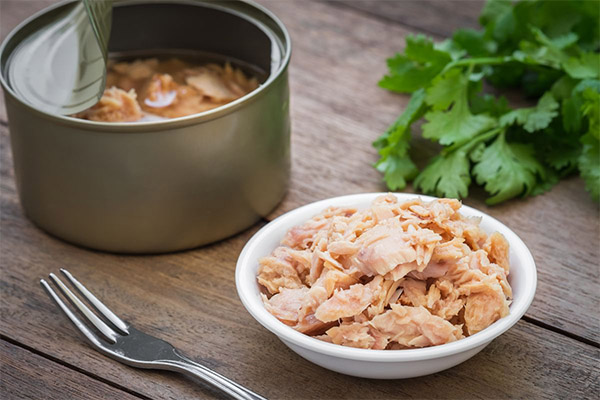
Selection rules for canned tuna
To minimize the risk of poisoning with low-quality products, when choosing canned fish, you should pay attention to the following criteria:
- Quality of packaging. The can should not have traces of rust and deformation, not to mention bloating. Such goods sellers have no right to sell at all.
- Labeling. Usually canned fish is marked on the inside, but sometimes the marking is applied with indelible paint on the outside. The factory label on the inside of the lid is considered the most reliable because it cannot be tampered with.
- Information on the label. Indicates the product code, date of manufacture. It is best to buy canned food produced no more than three months ago.
- The ratio between the liquid and the tuna meat in the can. For this purpose, it is necessary to shake the container well.
- Composition. In addition to tuna meat, the product may contain only salt and oil. No chemical additives in the jar should not be.
Important point! Currently, the manufacturers of canned fish make the label "dolphin friendly", meaning that the tuna was caught legally without violations of technology. This rule was introduced in order to preserve the dolphin population.
Can I Eat Tuna for Various Diseases
The chemical composition of all species of tuna fish, as well as the nutritional characteristics of their meat, testify to the incredible usefulness for overall human health. It is no coincidence that nutritionists have included this unique fish in all respects in the list of the safest and most desirable products for dietary nutrition of people with liver, heart, kidney, joint and digestive system diseases.
As noted above, tuna is recommended for consumption by athletes and people with weight problems. Medics advise including tuna meat dishes for those who have serious skin diseases, nervous disorders, musculoskeletal disorders and thyroid problems. In other words, tuna meat fully justifies the title of a universal dietary product. In some diseases, a diet including dishes of this valuable fish can have effects equivalent to therapeutic effect. Let's consider in detail several such cases of application.
For diabetes mellitus
Nutritionists believe that diabetics should definitely include tuna dishes in their diet. The almost complete absence of carbohydrates makes this product safe, that is, it eliminates the risk of elevated blood sugar concentrations. In addition, the content of Omega acids in the product, on the contrary, will help maintain insulin levels. The presence of minerals and vitamins will improve the overall condition of such patients. Diabetics are even allowed to consume canned tuna in its own juice. In short, a diet in which there is a place for tuna meat dishes will help increase the activity of diabetics, which as a result will improve the quality of life of such patients.
Useful Tip! It has been proven that the effectiveness of tuna meat can be increased by combining such a diet with drinking plenty of fluids. It is better to drink pure water and herbal teas.
Important: The glycemic index of tuna is 0 units.
For pancreatitis
The minimal percentage of fat in tuna meat creates favorable conditions for its consumption by patients with pancreatitis. This product is quickly digested by the digestive system without putting a strain on the pancreas. Boiled fish, as well as steamed dishes are easily absorbed by the body, providing it with the necessary complex of vitamins and minerals. Useful with pancreatitis pate of tuna fillets, light soups. For dietary meals, you need to choose fresh small fish, as the meat of older individuals can do more harm than good.
For gastritis
With gastritis, a properly chosen diet is one of the main components of the complex of therapy. Therefore, when choosing a food basket, you should always pay attention not only to the quality of individual products, but also to their useful properties. In this regard, saltwater fish, and especially tuna, can be considered an ideal product for dietary nutrition. Since the main sign of gastritis is the inflammatory process of the mucous tissues of the stomach, gently cooked dishes from sea delicacies can eliminate inflammation, improving the overall well-being of the patient. In addition, the content of Omega acids in fish meat will ensure the purification of the body from pathogenic microflora and the restoration of affected mucous membranes. A set of amino acids and mineral components will strengthen the immune system.
An important point! At exacerbation of gastritis it is strictly forbidden to eat canned fish. Neglecting this rule can lead to a worsening of the situation and cause such unpleasant side effects as diarrhea, bloating, heartburn.
In gout.
Gout is characterized by a disorder of the purine metabolism, as a result of which salts of uric acid begin to deposit in the joints. The disease occurs against the background of alternating periods of exacerbation and remission. The therapeutic complex of gout treatment, in addition to medications, includes a balanced diet. The nutrition program is constructed in such a way that foods rich in purines are completely eliminated from the diet.
Since most types of fish and seafood contain purines, especially during exacerbations fish dishes are completely removed from the menu. But in the remission stage of gout, the use of low-fat varieties of fish, which includes tuna, can be of significant benefit to the exhausted body of the disease. It is recommended that tuna dishes should be included in the daily diet no more than 2-3 times a week. In this case, the weight of a portion should not exceed 200-300 grams. Tuna should be steamed or baked in the oven as a dietary food for gout. The ideal option for this pathology would be to cook fish soup or a light fish soup. Dried and dried fish is prohibited for use with this disease.
Harms and contraindications
Despite the unanimous opinion of nutritionists regarding the benefits of tuna meat, there are a number of serious contraindications that should not be ignored. It is strictly forbidden to eat dishes made of this fish:
- children under 3 years of age;
- Pregnant and nursing women;
- People prone to allergic reactions;
- Patients with serious kidney dysfunctions;
- Individuals who have been found to have an individual intolerance to this type of seafood.
But even in those cases when nothing prevents you from enjoying the excellent taste of tender tuna meat, you should stick to the norm of consumption of the product.
Caution with this nutritious product is due to the fact that heavy metals accumulate in the meat of "advanced age" individuals. The most dangerous element among them is considered to be mercury, ingestion of which in the body can lead to disastrous health consequences.
How to choose and store
To choose a really good quality fish, you need to be guided by the following rules:
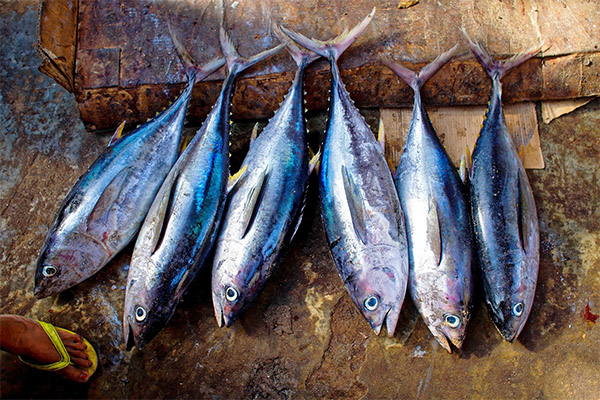
- When choosing a canned product, give preference to the option with low-calorie, that is, tuna in its own juice. When buying steaks, you need to assess the appearance of the products: the meat should not have spots and rainbow streaks.
- Cooled pieces of fish fillet have a pleasant fresh flavor, in which it is easy to guess the accents of the sea. A cut not of the first freshness will give off a pungent smell of slime.
- One should not forget about the peculiarities of tuna fillet color: it resembles beef in appearance.
- When choosing prepackaged products, one should carefully study the information content on the label, i.e. the date of manufacture of the product and the expiration date.
Basically, these are all the rules for choosing fresh fish semi-finished products. Since tuna belongs to the category of expensive products, you should not buy this fish in advance. It is enough to calculate the needs per family according to the formula: A 200-gram portion will satisfy the needs of one adult eater. For children half of this amount is enough.
Note! The rules for selecting canned tuna are described above. They do not differ in any way from the requirements for all fish products.
How to store tuna meat
The shelf life of both frozen and fresh fish products is limited. For example, fresh tuna fillets should be sold within 4 days, and frozen meat can be stored in the freezer for 2 weeks. Of course, it is best to store the product in the refrigerator. But for this process, the tuna fillet must be properly prepared:
- First, blot with paper towels to remove excess moisture.
- Then determine in a suitable container. An ordinary plate will do for a small piece of fillet.
- Wrap the plate with the fish semi-finished product on top in cling film. Store the fish in this form can be stored for 24 hours on the bottom shelf of the refrigerator.
- Canned tuna after opening the jar to put in a glass container with a lid. It is allowed to store such product for no more than one day.
- Unopened canned food should be stored in a dark cool place. Term out of the implementation is specified by the manufacturer on the label.
And one more very important nuance: thawed fish meat can not be subjected to repeated freezing, because such a procedure will deprive the valuable product of some of its useful qualities.
How to cut the tuna properly
Of course, acquiring a whole tuna carcass is an exceptional rarity. But if fate has pleased such a valuable gift, then you should properly cut the fish, so that the meat does not spoil. To do this:
- Wash the carcass thoroughly under running water.
- Remove the head and gills, then rinse again with water. Then separate the tail.
- The next stage of cutting is the removal of the innards. This is a very responsible procedure, which must be carried out carefully. Cut the abdomen carefully with a sharp knife along the midline. After removing the viscera, remove the black film, wash the carcass again.
- Next, remove the pelvic fin. For easier manipulation, trim the skin on the belly of the fish on both sides.
- Exactly the same steps to do in the location of the dorsal fin, and then remove it by gently pulling the end in the direction from the tail to the head.
- If it is decided to cook the fish without removing the skin, then thoroughly clean the tuna carcass of scales.
- If it is necessary to remove the skin, it is better to do it on the whole carcass, moving from the tail to the head first from one side, then from the other. The skin is usually well separated from the meat.
- Cut off the lower part of the abdomen (belly) as well. By the way, it's a great base for soup.
- Now separate the fillet part. To this end, make an incision along the spine of the fish carcass.
As a result of uncomplicated manipulation, the hostess will have at her disposal two thick pieces of tuna fillets plus a soup set.
A side note! The described way you can cut the carcass of any large fish.
How to cook tuna very well: Recipes
The encyclopedia of world cookery has collected a huge number of ways to prepare delicious and nutritious tuna meat dishes. This valuable product can be stewed and boiled, grilled and conventional pan fried. Here are the most popular home cooking options as an example.

In the oven
For a dietary diet, tuna stuffed with vegetables is optimal. The finished dish has a caloric value of 163 units, but a lot of proteins. To prepare a delicate delicacy in terms of taste, you will need:
- The carcass weighs up to 2 kg.
- Onion.
- 300g carrots.
- 400g fresh tomatoes.
- 170g butter.
- 6 tbsp. vegetable oil.
- Salt, spices for fish, bay leaf.
Sequence of cooking steps:
- Rinse fish carcass first, remove bones, remove the skin.
- Cut meat into pieces.
- Grate carrots and tomatoes, finely chop onion, fry separately in a pan.
- Then melt the butter. The resulting mass combine with a third of the grated carrots.
- Mix another part of carrots and onions with tomato mixture, put the mixture on fire and bring to the boil. Then add salt, spices and a few bay leaves.
- Pass the tuna through a mincer, add the rest of the onion and carrot, lightly salt.
- Rinse fish skin under running water and fill with the stuffing.
- Pour the tomato sauce into a deep container, then put the fish in it, pour the sauce on top.
- Bake the dish for exactly one hour at 180°C.
Stuffed tuna baked in the oven can be given to children. The dish turns out very tasty and filling.
In the pan
Fried tuna is easiest to prepare in the home kitchen. In terms of composition and calories, the dish is slightly different from other ways, except for a slight decrease in proteins. For 2 medium-sized steaks, you will need:
- 1 tsp. salt and the same amount of ground black pepper.
- ¼ tsp. cayenne pepper.
- 2 tbsp. vegetable oil (olive oil is preferred).
Cooking Algorithm:
- Rub tuna meat with spices.
- Heat oil in a frying pan, add cayenne pepper. Fry for 5 minutes.
- Then put fish fillets into the frying pan.
- Fry the meat on both sides for about 2 minutes.
Prepared in this simple way fish meat can be served with potatoes, rice, vegetables.
On grill
Of course, the number of calories grilled tuna steak far exceeds baked and boiled fish, but sometimes you can please the household with the original dish. For 500 g of clean fish fillets will need:
- The juice of half a lemon.
- 0,5 spoons of sea salt.
- Pepper, coriander, olive oil.
How to cook:
- Cut thick pieces of fillet into plates no thicker than 1.5 cm.
- Grind coriander and peppercorns in a mortar.
- Mix spices with olive oil and salt in a separate bowl.
- Pieces of fillet roll in this mixture and leave for half an hour to marinate.
- Then put the fish on a hot grill grate.
- Fry each side for 5 minutes. Inside the meat should remain tender pink.
- Serve the ready delicacy with any sauce.
In a multicooker
Quickly, but without compromising the taste, you can cook tuna in the multicooker. For a delicious fish dish will require:
- 0.7 kg of tuna fillets.
- 3 to 4 cloves of garlic.
- 3 medium sized tomatoes.
- 3 heads of onion.
- 2 bell peppers.
- Spices, salt, juice of one lemon.
Step by step cooking process:
- Salt fish steaks, rub with spices, sprinkle with lemon juice.
- While the meat marinates for about 15 minutes, slice the peppers and tomatoes into thin slices.
- Chop the garlic, dice the onion.
- Pour oil in a bowl of a multicooker, fry in it first onion and garlic, then add the vegetables.
- After 15 minutes, add slices of marinated tuna to the stewed vegetables.
- Cook the dish in the mode "Stew" for about half an hour.
On the grill
Tuna fillet on the grill turns juicy and fragrant. And you can cook a delicious fish delicacy very quickly, if you have half a kilo of fish fillet on hand and the following ingredients:
- 30 ml of lime juice.
- 60 ml of olive oil.
- Salt and spices.
It is best to use sea salt, but in the absence of this product, you can use ordinary cooking spices.
Cooking sequence:
- Rinse fish pieces, dry with napkins.
- In a separate bowl, mix lime juice with olive oil. Add salt, spices.
- Put the fish in an airtight bag, then add the marinade.
- Put the bag with the fish for half an hour in the refrigerator.
- Then put the marinated fish pieces on the grill.
- Fry each side for 5 minutes until golden crust.
Serve the finished deliciousness with fresh herbs, vegetables and even citrus fruits.
What to make with tuna: Recipes
It is no coincidence that tuna is a favorite of the world's best cooks. A lot of tasty and very healthy dishes can be prepared from the delicacy meat of this fish. For example, there are many variations of cooking the most unusual salads based on tuna.

Salad
We offer an original recipe for a fish snack with grapes and nuts. For 400 grams of fish fillets you will need:
- Lemon.
- A small bunch of grapes.
- 150g of yogurt.
- Glass of chopped walnuts.
Cooking steps:
- Rub the fish billet with the lemon zest.
- Send in the oven for 20 minutes at a temperature of 180 ° C.
- When ready divide the fillet with a fork into fibers.
- Combine the roasted nuts with grape berries, cut in half, add yogurt (unsweetened).
- Place the fish in a salad bowl, then the nut and grape mixture. Mix everything.
- Decorate the dish with lemon slices and grapes.
Tartar
This recipe of French cuisine implies cooking without using thermal treatment. Prepares an exquisite snack quickly, but provided that the freshness of the tuna fillet does not cause the slightest doubt.
For 200 g of the main product will require:
- 150 g each of onion and avocado.
- 1 tsp. mustard with lemon.
- 1 tbsp. olive oil.
- Salt, spices.
Preparation:
- Dice washed and dried fish fillets.
- Prepare the marinade with the ingredients listed. Dice the onion separately.
- Drizzle the fish with the marinade and mix.
- Dice avocado.
- Now place the avocado on the cold surface of the plate in layers, first the avocado, then the marinade fish.
- Decorate the top of the appetizer with fish roe or sesame seeds.
Soup
A delicious fish soup is the first course of canned tuna. It is made quickly from the usual set of products:
- 3 potatoes.
- Onion.
- Carrot.
- Jar of canned tuna.
- 2 hard-boiled eggs.
- Salt, spices.
- Butter.
- Tomato.
Cooking process:
- First, boil the potatoes in 1 liter of water.
- Add spices to the broth.
- Coarsely chop carrot and onion. Fry vegetables in butter, add tomato.
- Add the roasted vegetables to the broth, then after 2 minutes add the tuna.
- Add halves of hard-boiled eggs to the finished soup before serving.
Pâté
The easiest way to make tuna pâté according to the classic recipe. The whole procedure will take no more than a quarter of an hour. The finished appetizer can be used to make sandwiches. Basic ingredients:
- A can of canned tuna.
- 2 boiled eggs.
- 25 g mustard.
- 40 g of butter.
- Lemon.
- Salt, spices.
Cooking process:
- Open the can and drain off excess liquid.
- Place the canned tuna meat in a blender or chop it with a blender.
- Cut the eggs into four pieces and add them to the tuna.
- Season the mixture with salt, spices and lemon juice.
- Bring the mass to a state of puree.
- Before serving, add finely chopped fresh herbs to the ready fish pâté.
Note: Use a pastry bag with a notched tip to make the appearance of the tuna pâté appetizer attractive.
Carpaccio
Italian appetizer of raw seafood will please real gourmets. Tender fish fillet, complemented by the aroma of spices and olive oil, will be a worthy decoration of the holiday table. For the original appetizer you need:
- 200 g of tuna fillets.
- 30 ml of lemon juice.
- Sea salt.
- 30 ml of olive oil.
- Five pepper spice.
Step by step cooking process:
- Slightly frozen fish fillets cut into thin slices.
- Arrange the billets beautifully on a plate.
- Drizzle the fish slices with oil and lemon juice.
- Salt and pepper the carpaccio.
- Put in the fridge for a quarter of an hour.
- Before serving, garnish the appetizer with fresh arugula leaves.
Tuna carpaccio goes perfectly with white wine.
Cutlets
Steamed tuna fish cutlets will enrich your diet. This dish is suitable for children's meals, and also meets the requirements of the diet of thin people.
The necessary set of products includes the following components:
- 0.4 kg of tuna fillets.
- Onion.
- 70 g white bread.
- Potatoes.
- Egg.
- Salt, spices.
How to cook:
- Pass the fish meat through a meat grinder.
- Soak the bread in milk or water.
- Finely chop the onion, and grate the potatoes coarsely.
- Now combine all the components of the force-meat in one container, beat the egg, add spices.
- From the well-mixed mince form cutlets.
- On a heated and oiled baking tray, place the workpieces.
- Bake tuna cutlets at 180°C.
- In 20 minutes serve the tasty dish with any vegetable side dish, rice or pasta.
Here is just a small part of the culinary arsenal that is used daily in practice by the best chefs around the world. Interestingly, the collection of recipes is constantly being updated with new variations.
Can I Eat Raw Tuna
Many consumers are wary of eating raw fish. And indeed such fears are not unfounded, because parasites can settle in the meat of many sea and freshwater inhabitants. But tuna differs from other seafood just because of the purity of its meat. Specialists explain this fact by the special diet of this noble fish and its high motility, which does not please the organisms that are used to lead a parasitic way of life.
In Japanese cuisine they traditionally prepare sushi and rolls out of fresh tuna meat, which are popular all over the world. Our native lovers of Oriental cuisine have also long ago managed to appreciate the delicate taste of these culinary masterpieces. But it is recommended to prepare such snacks only from fresh fish.
Interesting facts
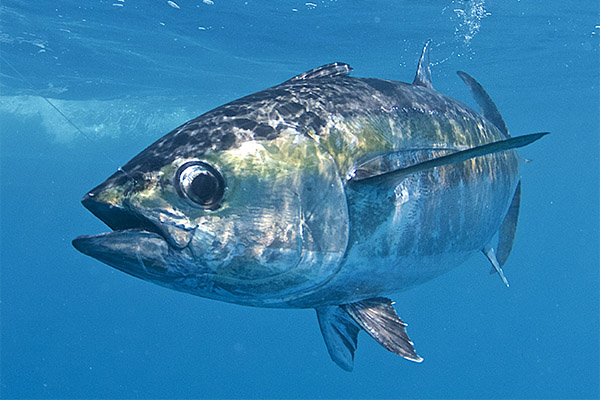
- In ancient times, tuna was surrounded by myths and legends. The unusual color of the meat gave rise to the belief that tuna is more of an animal than a fish. For this reason, in many countries tuna was not eaten for a long time.
- Tuna is capable of sprinting thanks to its special anatomy and its huge tail, which acts as a powerful gas pedal.
- At a Japanese auction in 2012, a huge tuna weighing over 220 kg was sold for a whopping $1.5 million.
- The first canned tuna meat appeared in the early twentieth century. But the reason for the production of such a popular product today was the shortage of sardines, which were processed at all large enterprises in the United States. To avoid bankruptcy, American industrialists took a desperate step, deciding to replace sardines with tuna.
To summarize, we can assure you that tuna deserves a place of honor on the menu of people who care about their own health and the well-being of their loved ones. This unique fish has unique gastronomic and medicinal properties.
«Important: All information on this site is provided for informational purposes only. for informational purposes only. Please consult with your health care professional before using any of the recommendations. specialist before using any of the recommendations. Neither the editors nor the authors shall be liable for any possible harm caused by materials."


